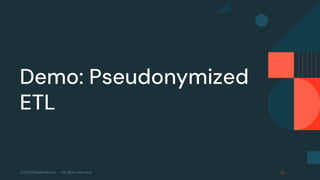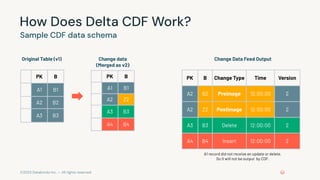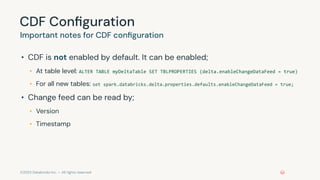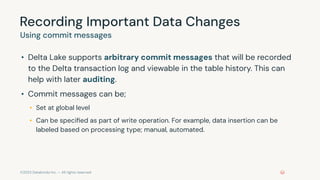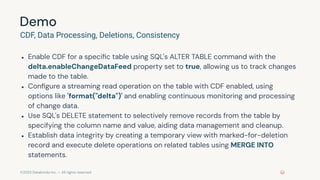Data Privacy Patterns in databricks for data engineering professional certification
- 1. ©2023 Databricks Inc. — All rights reserved Data Privacy Patterns
- 2. ©2023 Databricks Inc. — All rights reserved Agenda Data Privacy Patterns Lesson Name Lesson Name Lecture: Store Data Securely Lecture: Deleting Data in Databricks ADE 3.1 - Follow Along Demo - PII Lookup Table ADE 3.4 - Follow Along Demo - Processing Records from CDF ADE 3.2 - Follow Along Demo - Pseudonymized ETL ADE 3.5L - Propagating Changes with CDF Lab ADE 3.3 - Follow Along Demo - Deidentified PII Access ADE 3.6 - Follow Along Demo: Propagating Deletes with CDF Lecture: Streaming Data and CDF
- 3. ©2023 Databricks Inc. — All rights reserved Store Data Securely
- 4. ©2023 Databricks Inc. — All rights reserved Learning Objectives By the end of this lesson, you should be able to: Identify common use cases for data privacy and describe optimal approaches to meet compliance regulations 1 2 3 Secure and handle PII/sensitive data in data pipelines Create Dynamic views to perform data masking and control access to rows and columns
- 5. ©2023 Databricks Inc. — All rights reserved Regulatory Compliance • EU = GDPR (General Data Protection Regulation) • US = CCPA (California Consumer Privacy Act) • Simplified Compliance Requirements • Inform customers what personal information is collected • Delete, update, or export personal information as requested • Process request in a timely fashion (30 days)
- 6. ©2023 Databricks Inc. — All rights reserved Regulatory Compliance • Reduce copies of your PII • Find personal information quickly • Reliably change, delete, or export data • Built-in data skipping optimizations (Z-order) and housekeeping of obsolete/deleted data (VACUUM) • Use transaction logs for auditing How Databricks Simplifies Compliance
- 7. ©2023 Databricks Inc. — All rights reserved Manage Access to PII • Control access to storage locations with cloud permissions • Limit human access to raw data • Pseudonymize records on ingestion • Use table ACLs to manage user permissions • Configure dynamic views for data redaction • Remove identifying details from demographic views
- 8. ©2023 Databricks Inc. — All rights reserved PII Data Security • Protects data at record level • Re-identification is possible • Pseudonymised data is still considered PII Two main data modeling approaches to meet compliance requirements • Protects entire dataset • Irreversibly altered • Non-linkable to original data • Multiple anonymization methods might be used Pseudonymization Anonymization Name John Doe B_Date 14/04/1987 Name User-321 B_Date 14/04/1987 Name John Doe B_Date 14/04/1987 Name ********** Age 20-30
- 9. ©2023 Databricks Inc. — All rights reserved Pseudonymization • Switches original data point with pseudonym for later re-identification • Only authorized users will have access to keys/hash/table for re-identification • Protects datasets on record level for machine learning • A pseudonym is still considered to be personal data according to the GDPR • Two main pseudonymization methods: hashing and tokenization Overview of the approach
- 10. ©2023 Databricks Inc. — All rights reserved Pseudonymization • Apply SHA or other hash to all PII • Add random string "salt" to values before hashing • Databricks secrets can be leveraged for obfuscating salt value • Leads to some increase in data size • Some operations will be less efficient Method: Hashing ID SSN Salary_R 1 000-11-1111 53K 2 000-22-2222 68K 3 000-33-3333 90K 4 000-44-4444 72K ID SSN Salary_R 1 1ffa0bf4002a968e7d8 53K 2 1d55ec7079cb0a6at0 68K 3 be85b326855e0e748 90K 4 da20058e59fe8d311f 72K
- 11. ©2023 Databricks Inc. — All rights reserved Pseudonymization • Converts all PII to keys • Values are stored in a secure lookup table • Slow to write, but fast to read • De-identified data stored in fewer bytes Method: Tokenization ID SSN Salary_R 1 000-11-1111 53K 2 000-22-2222 68K 3 000-33-3333 90K 4 000-44-4444 72K ID SSN Salary_R 1 1ffa0bf4002a968e7d8 53K 2 1d55ec7079cb0a6at0 68K 3 be85b326855e0e748 90K 4 da20058e59fe8d311f 72K SSN SSN_Token 000-11-1111 1ffa0bf4002a968e7d8 000-22-2222 1d55ec7079cb0a6at0 000-33-3333 be85b326855e0e748 000-44-4444 da20058e59fe8d311f Token Vault
- 12. ©2023 Databricks Inc. — All rights reserved Anonymization • Protects entire dataset (tables, databases or entire data catalogues) mostly for Business Intelligence • Personal data is irreversibly altered in such a way that a data subject can no longer be identified directly or indirectly • Usually a combination of more than one technique used in real-world scenarios • Two main anonymization methods: data suppression and generalization Overview of the approach
- 13. ©2023 Databricks Inc. — All rights reserved Anonymization Methods • Exclude columns with PII from views • Remove rows where demographic groups are too small • Use dynamic access controls to provide conditional access to full data Method: Data Suppression Source Table ID SSN Salary_R 1 000-11-1111 53K 2 000-22-2222 68K 3 000-33-3333 90K View with no PII ID Salary_R 1 53K 2 68K 3 90K
- 14. ©2023 Databricks Inc. — All rights reserved • Categorical generalization • Binning • Truncating IP addresses • Rounding Anonymization Methods Method: Generalization
- 15. ©2023 Databricks Inc. — All rights reserved • Removes precision from data • Move from specific categories to more general • Retain level of specificity that still provides insight without revealing identity Anonymization Methods Method: Generalization → Categorical Generalization
- 16. ©2023 Databricks Inc. — All rights reserved Anonymization Methods • Identify meaningful divisions in data and group on boundaries • Allows access to demographic groups without being able to identify individual PII • Can use domain expertise to identify groups of interest Method: Generalization → Binning ID Department BirthDate 1 IT 28/09/1997 2 Sales 13/02/1976 3 Marketing 02/04/1985 4 Engineering 19/12/2002 ID Department Age_Range 1 IT 20-30 2 Sales 40-50 3 Marketing 30-40 4 Engineering 20-30
- 17. ©2023 Databricks Inc. — All rights reserved Anonymization Methods IP addresses need special anonymization rules; • Rounding IP address to /24 CIDR • Replace last byte with 0 • Generalizes IP geolocation to city or neighbourhood level Method: Generalization → Truncating IP addresses ID IP IP_Truncated 1 10.130.176.215 10.130.176.0/24 2 10.5.56.45 10.5.56.0/24 3 10.208.126.183 10.208.126.0/24 4 10.106.62.87 10.106.62.0/24
- 18. ©2023 Databricks Inc. — All rights reserved Anonymization Methods • Apply generalized rounding rules to all number data, based on required precision for analytics • Example: • Integers are rounded to multiples of 5 • Values less than 2.5 are rounded to 0 or omitted from reports • Consider suppressing outliers Method: Generalization → Rounding ID Department Age_Range Salary 1 IT 20-30 1245.4 2 Sales 40-50 1300 3 Marketing 30-40 1134 ID Department Age_Range Salary_R 1 IT 20-30 1200 2 Sales 40-50 1300 3 Marketing 30-40 1100
- 19. ©2023 Databricks Inc. — All rights reserved Knowledge Check
- 20. ©2023 Databricks Inc. — All rights reserved Which of the following terms refers to irreversibly altering personal data in such a way that a data subject can no longer be identified directly or indirectly? Select one response A. Tokenization B. Pseudonymization C. Anonymization D. Binning
- 21. ©2023 Databricks Inc. — All rights reserved Which of the following is a regulatory compliance program specifically for Europe? Select one response A. HIPAA B. PCI-DSS C. GDPR D. CCPA
- 22. ©2023 Databricks Inc. — All rights reserved Which of the following are examples of generalization? Select two responses A. Hashing B. Truncating IP addresses C. Data suppression D. Binning
- 23. ©2023 Databricks Inc. — All rights reserved Which of the following can be used to obscure personal information by outputting a string of randomized characters? Select one response A. Tokenization B. Categorical generalization C. Binning D. Hashing
- 24. ©2023 Databricks Inc. — All rights reserved Demo: PII Lookup Table
- 25. ©2023 Databricks Inc. — All rights reserved Demo: Pseudonymized ETL
- 26. ©2023 Databricks Inc. — All rights reserved
- 27. ©2023 Databricks Inc. — All rights reserved Demo: De-identified PII Access
- 28. ©2023 Databricks Inc. — All rights reserved Streaming Data and CDF
- 29. ©2023 Databricks Inc. — All rights reserved Learning Objectives By the end of this lesson, you should be able to: Explain how CDF is enabled and how it works 1 2 3 Discuss why ingesting from CDF can be beneficial for streaming data Articulate multiple strategies for using Streaming data to create CDF 4 Discuss how CDF addresses past difficulties propagating updates and deletes
- 30. ©2023 Databricks Inc. — All rights reserved Streaming Data and Data Changes Updates and Deletes in streaming data • In Structured Streaming, a data stream is treated as a table that is being continuously appended. Structured Streaming expects to work with data sources that are append only. • Changes in existing data (updates and deletes) breaks this expectation! • We need a deduplication logic to identify updated and deleted records. • Note: Delta transaction logs tracks files than rows. Updating a single row will point to a new version of the file.
- 31. ©2023 Databricks Inc. — All rights reserved Solution 1: Ignore Changes Prevent re-processing by ignoring deletes, updates and overwrites • Ignore transactions that delete data at partition boundaries • No new data files are written with full partition removal • spark.readStream.format("delta") .option("ignoreDeletes", "true") • Allows stream to be executed against Delta table with upstream changes • Must implement logic to avoid processing duplicate records • Subsumes ignoreDeletes • spark.readStream.format("delta") .option("ignoreChanges", "true") Ignore Deletes Ignore Changes
- 32. ©2023 Databricks Inc. — All rights reserved Solution 2: Change Data Feeds (CDF) Propage incremental changes to downstream tables Raw Ingestion and History BRONZE Filtered, Cleaned, Augmented SILVER Business-level Aggregates GOLD Change Data Feed (CDF) External feeds, Other CDC output, Extracts AI & Reporting Streaming Analytics
- 33. ©2023 Databricks Inc. — All rights reserved What Delta Change Data Feed Does for You Benefits and use cases of CDF Meet regulatory needs Full history available of changes made to the data, including deleted information BI on your data lake Incrementally update the data supporting your BI tool of choice Unify batch and streaming Common change format for batch and streaming updates, appends, and deletes Improve ETL Pipelines Process less data during ETL to increase efficiency of your pipelines by processing only row-level changes
- 34. ©2023 Databricks Inc. — All rights reserved How Does Delta CDF Work? Sample CDF data schema PK B A1 B1 A2 B2 A3 B3 Original Table (v1) PK B A1 B1 A2 Z2 A3 B3 A4 B4 Change data (Merged as v2) PK B Change Type Time Version A2 B2 Preimage 12:00:00 2 A2 Z2 Postimage 12:00:00 2 A3 B3 Delete 12:00:00 2 A4 B4 Insert 12:00:00 2 Change Data Feed Output A1 record did not receive an update or delete. So it will not be output by CDF.
- 35. ©2023 Databricks Inc. — All rights reserved Consuming the Delta CDF Stream-based Consumption ● Delta Change Feed is processed as each source commit completes ● Rapid source commits can result in multiple Delta versions being included in a single micro-batch Batch Consumption ● Batches are constructed based in time-bound windows which may contain multiple Delta versions A2 B2 Preimage 12:00:00 2 A2 Z2 Postimage 12:00:00 2 A3 B3 Delete 12:00:00 2 A4 B4 Insert 12:00:00 2 A5 B5 Insert 12:08:0 0 3 A6 B6 Insert 12:09:00 4 A6 B6 Preimage 12:10:05 5 A6 Z6 Postimage 12:10:05 5 A5 B5 Insert 12:08:00 3 A6 B6 Insert 12:09:00 4 12:00 A6 B6 Preimage 12:10:05 5 A6 Z6 Postimag e 12:10:05 5 12:10:0 0 12:20 12:08 12:10:10 Stream - micro batches Batch - every 10 mins 12:00
- 36. ©2023 Databricks Inc. — All rights reserved CDF Configuration Important notes for CDF configuration • CDF is not enabled by default. It can be enabled; • At table level: ALTER TABLE myDeltaTable SET TBLPROPERTIES (delta.enableChangeDataFeed = true) • For all new tables: set spark.databricks.delta.properties.defaults.enableChangeDataFeed = true; • Change feed can be read by; • Version • Timestamp
- 37. ©2023 Databricks Inc. — All rights reserved Deleting Data in Databricks
- 38. ©2023 Databricks Inc. — All rights reserved Learning Objectives By the end of this lesson, you should be able to: Explain the use case of CDF for removing data in downstream tables 1 2 3 Describe various methods of recording important data changes Discuss how CDF can be leveraged to ensure deletes are committed fully
- 39. ©2023 Databricks Inc. — All rights reserved Data Deletion in Databricks Data deletion needs special attention! • Companies need to handle data deletion requests carefully to main compliance with privacy regulations such as GDPR and CCPA. • PII for users need to be effectively and efficiently handled in Databricks, including deletion. • These operations usually handled in pipelines separate from ETL pipelines. • CDF data can be used to propagate deletion action to downstream table.
- 40. ©2023 Databricks Inc. — All rights reserved Recording Important Data Changes Using commit messages • Delta Lake supports arbitrary commit messages that will be recorded to the Delta transaction log and viewable in the table history. This can help with later auditing. • Commit messages can be; • Set at global level • Can be specified as part of write operation. For example, data insertion can be labeled based on processing type; manual, automated.
- 41. ©2023 Databricks Inc. — All rights reserved Propagating Data Deletion with CDF How can CDF be used for propagating deletes? • Data deletion requests can be streamlined with automated triggers using Structured Streaming. • CDF can be separately leveraged to identify records need to be deleted or modified in downstream tables. Note: When Delta Lake's history and CDF features are implemented, deleted values are still present in older versions of the data. • We can solve this by deleting at a partition boundary.
- 42. ©2023 Databricks Inc. — All rights reserved CDF Retention Policy Important notes for CDF configuration • File deletion will not actually occur until we VACUUM our table! • CDF records follow the same retention policy of the table. VACUUM command deletes CDF data. • By default, the Delta engine will prevent VACUUM operations with less than 7 days of retention. To manually run VACUUM for these files; • Disable Spark’s retention duration check (retentionDurationCheck.enabled) • Run VACUUM with DRY RUN to preview files before permanently removing them • Run VACUUM with RETAIN 0 HOURS!
- 43. ©2023 Databricks Inc. — All rights reserved Can I perform DML on a Live Table? (i.e. GDPR) 43
- 44. ©2023 Databricks Inc. — All rights reserved Example GDPR use case Using streaming live tables for ingestion and live tables after 44 Staging Bronze Silver Gold CREATE STREAMING LIVE TABLE CREATE LIVE TABLE CREATE LIVE TABLE {JSON files} Limited Retention Configurable Retention Correction / GDPR LIVE Tables automatically reflect changes made to inputs
- 45. ©2023 Databricks Inc. — All rights reserved How can you fix it? Updates, deletes, inserts and merges on streaming live tables. Ensure compliance for retention periods on a table. DELETE FROM my_live_tables.records WHERE date < current_time() – INTERVAL 3 years Scrub PII from data in the lake. UPDATE my_live_tables.records SET email = hash(email, salt) 45
- 46. ©2023 Databricks Inc. — All rights reserved DML works on streaming live tables only DML on live tables is undone by the next update UPDATE users SET email = obfuscate(email) Live Table Streaming Live Table 46 id 1 Users email ****@gmail.com CREATE OR REPLACE users AS …. [email protected] UPDATE users SET email = obfuscate(email) id 1 Users email ****@gmail.com 2 ****@hotmail... INSERT INTO users …
- 47. ©2023 Databricks Inc. — All rights reserved Demo: Processing Records from CDF
- 48. ©2023 Databricks Inc. — All rights reserved Lab: Propagating Changes with CDF
- 49. ©2023 Databricks Inc. — All rights reserved Learning Objectives By the end of this lesson, you should be able to: ● Learn how to activate Change Data Feed (CDF) for a specific table. ● Understanding of how to set up a streaming read operation to access and work with the change data generated by CDF. ● Demonstrate how to use SQL's DELETE statement to remove specific records from a table based on criteria and then verify the success of those deletions. ● Ensure data consistency by propagating delete operations from one table to related tables when records are deleted in one table.
- 50. ©2023 Databricks Inc. — All rights reserved Demo CDF, Data Processing, Deletions, Consistency ● Enable CDF for a specific table using SQL's ALTER TABLE command with the delta.enableChangeDataFeed property set to true, allowing us to track changes made to the table. ● Configure a streaming read operation on the table with CDF enabled, using options like 'format("delta")' and enabling continuous monitoring and processing of change data. ● Use SQL's DELETE statement to selectively remove records from the table by specifying the column name and value, aiding data management and cleanup. ● Establish data integrity by creating a temporary view with marked-for-deletion record and execute delete operations on related tables using MERGE INTO statements.
- 51. ©2023 Databricks Inc. — All rights reserved Demo: Propagating Deletes with CDF
- 52. ©2023 Databricks Inc. — All rights reserved Knowledge Check
- 53. ©2023 Databricks Inc. — All rights reserved Which of the following terms refers to irreversibly altering personal data in such a way that a data subject can no longer be identified directly or indirectly? Select one response A. Tokenization B. Pseudonymization C. Anonymization D. Binning
- 54. ©2023 Databricks Inc. — All rights reserved Which of the following is a regulatory compliance program specifically for Europe? Select one response A. HIPAA B. PCI-DSS C. GDPR D. CCPA
- 55. ©2023 Databricks Inc. — All rights reserved Which of the following are examples of generalization? Select two responses A. Hashing B. Truncating IP addresses C. Data suppression D. Binning
- 56. ©2023 Databricks Inc. — All rights reserved Which of the following can be used to obscure personal information by outputting a string of randomized characters? Select one response A. Tokenization B. Categorical generalization C. Binning D. Hashing
- 57. ©2023 Databricks Inc. — All rights reserved Change feed can be read by which of the following? Select two responses A. Version B. Date modified C. Timestamp D. Size
























